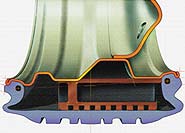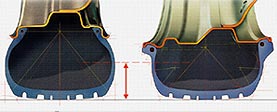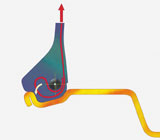Tyres are quite a complicated piece of technology, most
people think that they are simply a rubber ring that is there to grip
the road and help stop the road bumps being transferred to the car.
However 'gripping' the road is not as simple as it sounds
given the various extreme conditions that our everyday tyres have to put
up with. Extremes of temperature, extremes of dry and wet conditions,
extremes of cornering forces, acceleration forces and braking forces.
A tyre has to deform slightly at the point of contact
with the road for instance in, order to achieve any change of direction
or speed and it has to do this in a progressive and predictable way in
all the extremes of conditions that driving on the road throws at it.
It has to do this also without excessive wear, damage or permanent deformation.
Pneumatic
Tyres
Because Rubber Pneumatic tyres can deform in order to take
up small irregularities in the road surface the suspension and chassis
are spared the vibration that would be transferred if the tyres where
solid.
Top
Ten Tyre Tips.
Tyre
Ratings
Tyre
Size Coding
Tyre
Pressures
PAX
Developed by Michelin.
A future concept in Tyre safety on the road now.
The mounted
assembly has 4 main parts.
1. The Alloy
wheel
The Pax System wheel has multiple diameters with different seats which
makes the support easy to insert, and on which the tyre rests in case
of a flat tyre.
2. The Support
If the tyre loses pressure and runs flat the support provides two functions.
Support the load of the vehicle, since air pressure no longer plays this
role.
Provide tread contact and maintain proper handling of the vehicle.
3. The Tyre
This anchoring is no longer pneumatic as it is for traditional tyres:
it becomes mechanical. Any stress on the tyre has the consequence of screwing
the tyre more tightly to the rim.
4. Pressure Detector
A sensor inserted in each wheel measures the pressure and relays the information
to the inside of the vehicle: It's role is to alert the driver of an abnormal
loss of pressure in one of the vehicles tyres as Pax system continues
to perform acceptably in deflated mode: the driver will not always be
aware that he is driving under an abnormal situation.
Advantages
Thanks to its conception, PAX SYSTEM offers totally new advantages,
without compromising the classic performance of a traditional mounted
assembly.
See more info below.
Technology
Redesigned anchoring system, short sidewalls, integrated pressure level
detector. See more info below.
Services
A choice of equipped and trained sales outlets, 24 hours assistance, and
innovative services using new technologies.
Advantages
1. The insurance of the same level of performance as with a short
sidewalls sports tyre.
2. Even if there is no air pressure in one or more of the vehicle's
tyres, the driver remains mobile and keeps the choice in choosing the
place and the moment for replacement.
3. Control of the vehicle in all situations, no forced immobilization
in a potentially dangerous zone.
4. New design and styling possibilities for the future vehicles.
5. Lower fuel emissions and less road noise.
6. The entire rear architecture and habitability of future vehicles
is going to be redesigned.
On The Road
Now
The arrival of PAX SYSTEM on the Scenic in mid-2001 marked the start of
a new phase: deployment on volume produced vehicles.
Renault is the first automaker to announce the arrival of PAX SYSTEM on
a volume produced vehicle. PAX SYSTEM will be optional on the new Renault
Scenic. Spacity for summer and Alpin for winter. The validation and integration
stages have been completed.
To accelerate the development process, Renault and Michelin worked closely
together at every stage in the chain, from design to marketing, including
the sales and after-sales networks.
Dimensions of PAX SYSTEM 195-620 R 420 A on Spacity for summer, Alpin
for winter.
Innovation at the service of safety PAX SYSTEM is an essential part of
the work conducted by Renault to achieve continuous improvements in vehicle
safety. Unveiled at Geneva, the new Scenic will be the first volume produced
vehicle to be fitted with tyres that cannot be unseated.
| |
Because the inside and outside
anchoring diameters of the wheel are different, it is easy to insert
an injected elastomer or polyurethane flexible support ring inside
the tire.
The support functions in two ways :
- Support the load of the vehicle, when the tire is flat, since air
pressure no longer plays this role.
- Provide necessary contact, which will allow the vehicle to keep
an acceptable grip on the road, at the adapted speed. When the tire
comes to rest on the support ring, tread contact will then be maintained,
thus ensuring proper handling of the vehicle. |
| |
Because PAX SYSTEM anchoring
system is now mechanical instead of pneumatic, the transition area
is therebyeliminated. On a traditional the deflection of this area
consumes energy and hinders the work of the sidewalls, especially
when the vehicle is cornering.Its elimination with PAX SYSTEM highly
improves road handling and driving pleasure.
|
| |
PAX SYSTEM is
anchored by a mechanical locking mechanism. Any force acting on the
tire increases the tension of the casing and thus the force of the
lock, even at zero pressure. The rubber at the far end of the anchoring
system is thereby compressed in the groove, locking everything in
place: PAX SYSTEM can not be unseated. |


